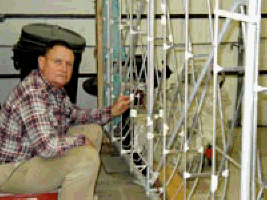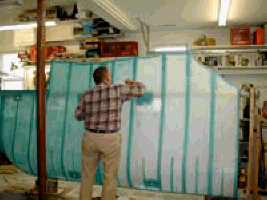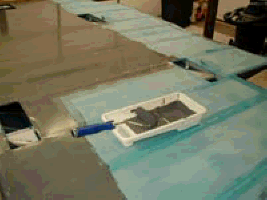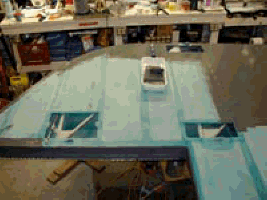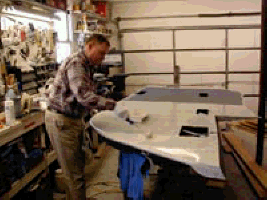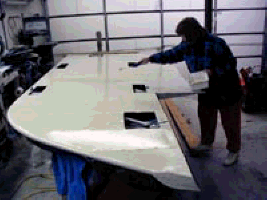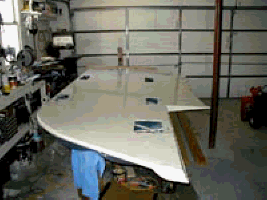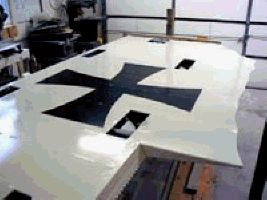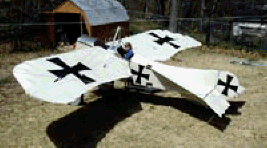Rolling Poly Paint: A Spray Painting Alternative
By Dick Starks (originally published in EAA Sport Aviation, June 2001)
“Oh, good grief!” I muttered in horrified disbelief. “Not now,” I pleaded. “Oh no, please, not now!”
A sharp, sinister snap told me that a circuit breaker had popped. Everything in my crowded little garage workshop came to a screeching halt. Smoke rose in a tiny mushroom cloud from my newly dead air compressor. The motor had burned out in a dramatic flash.
The timing couldn’t have been worse. The right wing of my Taube, “Dove of War” replica lie there, an acre of Ceconite waiting for something to happen. I’d just finished sealing the fabric with AFS (Aircraft Finishing Systems) CecoBond, and I was ready to start spraying the AFS CecoFill UV protection and sealer.
This was a very bad thing to have happen at that moment. I called the local authorized air compressor repair station and heard the words, “You’re looking at least a week to get it repaired. Bring it in, and we’ll put you in the lineup to be fixed, and it’ll take weeks for the parts to get here.”
Rats! My project was dead in the water, another setback in an unending line of challenges. I moodily sucked on a frosty Caffeine Free Diet Dr Pepper and pondered my options. Stopping work and waiting wasn’t an option I’d accept.
Drastic times call for drastic measures. I dialed AFS’s toll-free number and got my first break of the day. Tammy Yedinak, the covering guruette, answered the phone.
“Tammy!” I screamed into the phone. “I’m in deep dinosaur dung! I’ve got the wing ready for CecoFill, and my air compressor just threw craps on me!” I took a deep breath (screaming in a panic kind of takes your breath away) and asked, “What can I do?”
|
|
|
|
Before covering, all the rivet heads and sharp edges were covered with cloth anti-chafing tape. |
Sealing the Ceconite fabric with 5 percent-thinned CecoBond cement. |
Tammy never gets excited. In a soothing voice to calm me down, she said, “Shaddup, you big crybaby and listen.” (Tammy and I go back a long way, and this wasn’t the first time she’d saved my butt.) “You can wait for the air compressor to get fixed or go ahead and CecoFill the wing with a foam roller and brush.”
Huh?
She then reminded me that you can apply AFS’s CecoFill filler/sealer and its Two-Part Poly with a fine-finish foam roller and fine-bristle brush and get fantastic results. It’s called “rolling and tipping.” You roll it on, and then, before the paint sets, you drag a synthetic fine-bristle brush lightly over the surface to burst any bubbles and remove any “tracks.” As the paint sets, it flows out to a smooth, flawless high-gloss finish.
As Tammy explained what and how, I started to hope. Maybe I could keep on rocking and rolling on my project. Spring was on its way, and I wanted to get this monster in the air before winter set in again.
|
|
|
|
With the wing's fabric sealed against pinholes using thinned CecoBond cement, the CecoFill is rolled on to provide UV protection and some more filling of the weave. Once the CecoFill is dry to the touch but not cured, buffing it with a piece of Ceconite smoothes it out even more. The white cloth gloves are so I don't leave any oily fingerprints. With care, no sanding of the surface is necessary. |
|
She told me to check my e-mail because she was sending me detailed instructions on how to do it and some shots of her and AFS painting guru John Hanson using rollers and brushes to cover, seal, and paint the test frames in their covering classes. Her e-mail was waiting for me, and in the photos the rolled-on paint looked pretty darn good, too. (And, even better for me, it looked easy!)
All I needed to get started was the appropriate rollers and brushes, and I ordered them online (see “Resources” box)-with overnight air delivery. Then I poured another frosty Caffeine Free Diet Dr Pepper down my pipe and waited.
|
|
|
Rolling and tipping on the first coat of AFS Two-Part Polyurethane paint. After rolling the paint on two rib panels, I'd come back with a foam brush and lightly "tip" out any bubbles or roller "tracks." |
After 15 minutes I started to fidget and breathe heavy. Patience is not one of my virtues. I was anxious to start work, so I visited the nearest paint store to see if it had any “fine-finish” high-density foam rollers, used to apply varnish and lacquer to furniture. I bought some likely looking prospects and returned home with a spring in my step.
I carefully read the e-mailed directions, and they said to make sure there wasn’t any “trash” on the wing. I looked. Nope. All my tools were scattered all over the floor and piled helter-skelter on the bench.
Calling Tammy again, I found out that in painter’s terms “trash” means surface contamination, and she said to give the wing a dang good cleaning with AFS’s Heavy Duty Cleaner-and to let it dry overnight before even thinking about doing anything else. She also told me to thoroughly wash and rinse my new rollers and brush, too, to make sure they didn’t have any oil or wax in them.
Tammy said that if I wanted to guarantee a perfect finish, I needed to burn incense, intone a special chant, and do a complicated shuffle dance while slinging chicken blood around the garage. I thought this was a bit much, but with my record, I figured I needed all the help I could get. So, I did it all. I cleaned, dried, washed, wiped-and waited.
|
|
|
Sharon Starks rolls on the last coat of AFS Two-Part Poly paint on the wing. |
The next morning the wing was dry. The rollers were dry. The brushes were dry. The chicken blood was dry. It was time to paint!
After running a pint of CecoFill through a strainer to filter the really big chunks, I started rolling on the black UV protector and filler. Hey! This wasn’t too bad. It was way better than my spray gun work (we won’t go there).
The finish was smooth and even. Even better, no runs snaked their ugly, obnoxious way down the wing (we won’t go there, either). The CecoFill had flowed out so smooth I didn’t even need to tip the finish with the brush.
|
|
|
The finished wing was allowed to cure for two days before being turned over to do the other side. |
Still following directions, after the CecoFill had “almost” dried I buffed it with a piece of clean Ceconite cloth. Dang! It was so smooth that it didn’t need sanding! (Oh, man, do I hate sanding fabric. I’m always sanding a hole in it. Not having to sand was a very good thing.)
After waiting two hours, I turned the wing over and applied CecoFill and buffed the other side. Tammy told me to let the wing dry overnight so the CecoFill could “out gas.” (I didn’t know paint did that.)
The next morning the Dove of War’s wing was ready for paint. Up early, I followed the directions and leaned the heck out of the bottom of the wing with the AFS Heavy Duty Cleaner and let it dry. While I was waiting, the super-duper rollers arrived.
I catalyzed a batch of AFS Two-Part Polyurethane topcoat and got ready to rock and roll.
It went as well as the CecoFill. After rolling and tipping the first light coat, I let it dry until it was tacky (about 10 minutes). Then I rolled and tipped a light “cross coat” (in strokes perpendicular to those used to apply the first coat) and allowed it to “tack” dry (another 10 to 15 minutes). If the roller wouldn’t follow a curve, I used the fine-bristle synthetic brush. This coat was allowed to tack dry, too. One more coat to go.
|
|
|
After curing for a week, decals can be applied. The finished wing with the iron cross. |
Painting was going so well I went in the house, put my Credence Clearwater Revival CD on the stereo, and programmed it to repeat Proud Mary. I ran back to the garage after cranking the volume to “ya ha.”
Singing at the top of my lungs, I applied the final “wet” cross coat-“Big wheel keep on turning, Proud Mary keep on burning, Rolling, rolling, rolling on the poly paint!” (My wife, Sharon, took the dogs for a walk.)
After a little final tipping with the fine-bristle synthetic brush, the wing was done, and it looked just swell. Again, no runs! (For me, painting, this was a first!) I had to wait two days for the paint to cure before I could paint the other side of the wing. As time passed the finish looked better and better as it flowed out to a smooth, glossy finish.
The air compressor repair station called and said it found the part it needed and I could reclaim my huffer. I said I’d be in to pick it up “tomorrow.” I didn’t need it in a hurry anymore. Life was sweet and full.
I’ve been using AFS paint and covering products for more than 10 years. I used it when I covered my Kolb Twinstar in 1988. And the Kansas City Dawn Patrol used AFS when we re-covered our four Nieuport 11 replicas after the flood of ’93. I recovered the Kolb, too, because it spent three weeks under water with the Nieuports.
|
|
|
Sharon Starks checks out the visibility (which will be better than it appears) from the pilot's cockpit of the Taube. All the sheet metal and tail surfaces were painted with the rolling and tipping technique. This will be Sharon's plane. She's already taildragger certificated with over 200 hours in the Kolb Twinstar we own, but the Taube will be a new and wonderful experience for her with that big old nose out in front. |
AFS paints are nonvolatile, nonhazardous, and EPA/OSHA-safe, so you can ship them UPS with no worry and no HazMat charge. You can paint by an open fire without worrying about launching yourself into orbit, and all AFS products clean up with water. And, most impressive-and important-they don’t stink up the house!
AFS gives excellent product support and is always available to give help, advice, and encouragement. They also travel across the nation to give covering and painting seminars.
When I re-covered the dope and fabric parts on my 1946 Cessna 120 back in 1982, She Who Must Be Obeyed (my spouse, for those of you who don’t have one) informed me that I was never going to be allowed to use that “stinky stuff” in our house again.
So, if you’re in the mood to try something easier than spraying with a lot less mess and cleanup time, give the foam roller and synthetic brush a try. You might like it. You might really look into it if you want poly paint and don’t have an air compressor and a good HVLP (high-volume, low-pressure) spray gun.
Because I always like to get back “on the horse that threw me,” when I finally picked up my compressor I spray painted the top of the wing. Half-way through I was wishing I hadn’t. You’ll notice there aren’t any photos of it here. It’s the part with all the runs. (If you want to see more of the Taube, visit www.kcdawnpatrol.org and scroll down to “Taube.”)
Resources
AFS
P.O. Box 16418
Missoula, MT 59804
Phone: 800/653-7200,
406/251-1373
Fax: 406/251-1375
E-mail: afs@aircraftfinishing.com
www.aircraftfinishing.com
Rollers & Brushes
Jamestown Distributors
500 Wood Street, Bldg #15
Bristol, RI 02809
Phone: 800/423-0030,
401/253-3840
Fax: 401/254-5829
www.jamestowndistributors.com
Roller: Item FOAM7, yellow roller for smooth finishes, $1.97 per pair
Purdy Corporation
P.O. Box 83097
Portland, OR 97283-0097
Phone: 503/286-8217
Fax: 503/286-5336
E-mail: info@purdycorp.com
www.purdycorp.com
Brush: Nylox-Sprig, 3-inch
Purdy also carries foam rollers.
